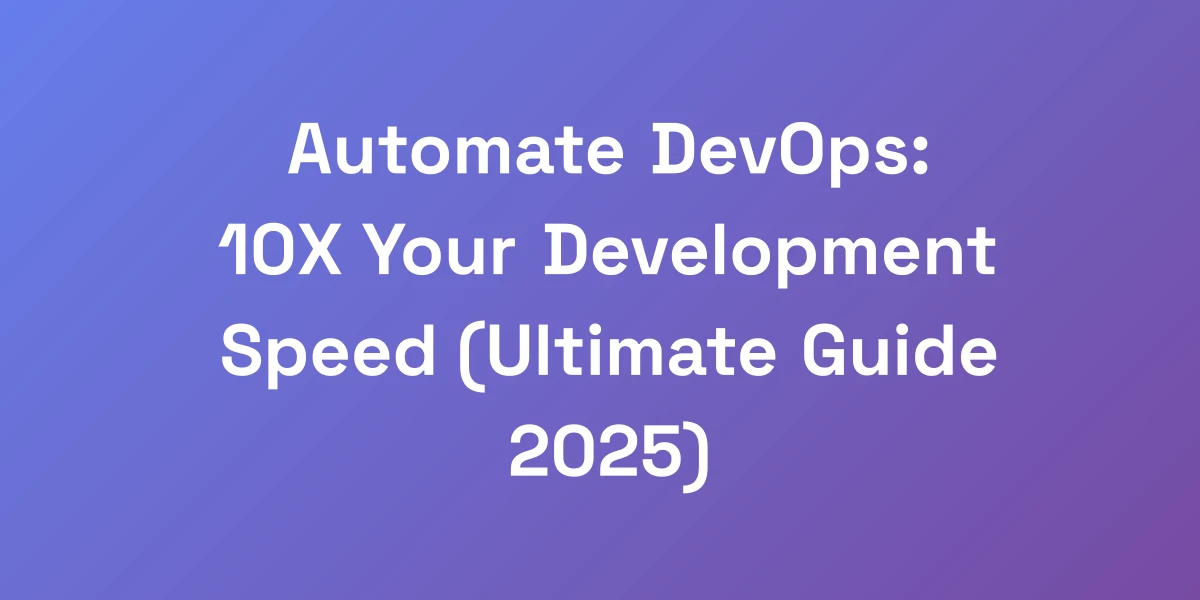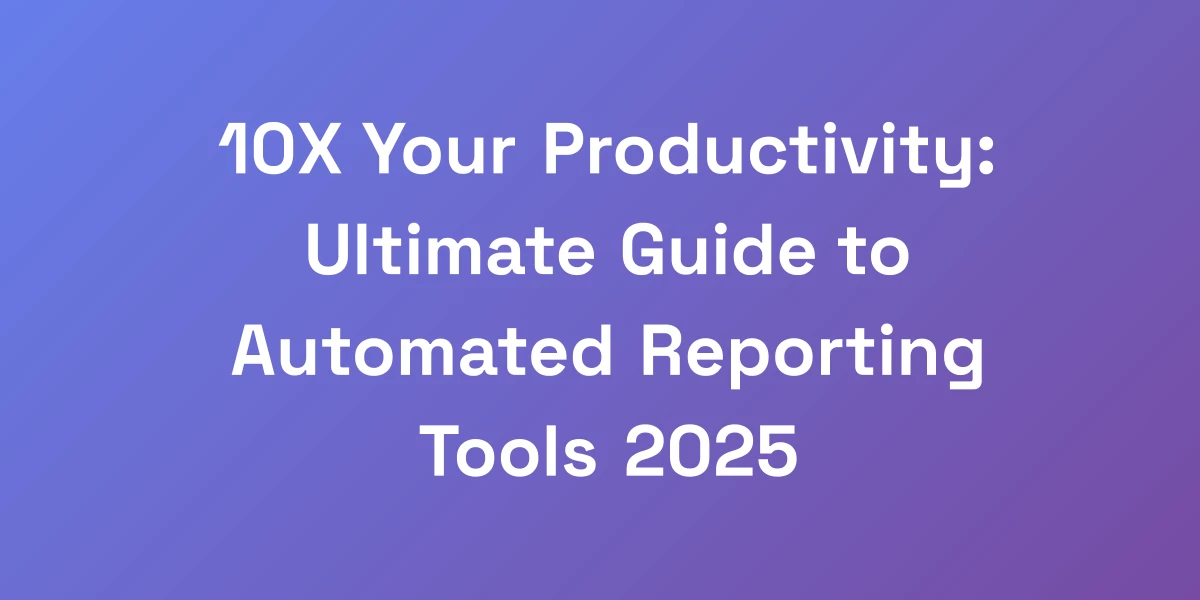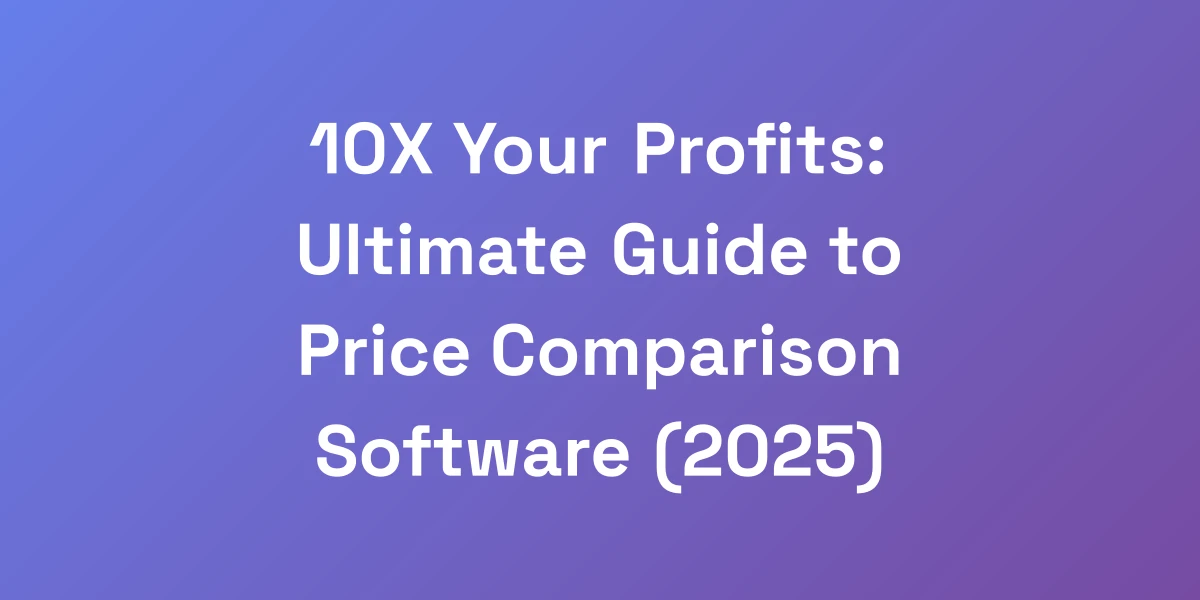
Automate DevOps: 10X Your Development Speed (Ultimate Guide 2025)
Mar 11, 2025 | By [email protected]
Introduction
Ever felt like your DevOps processes are stuck in a never-ending loop of inefficiency?
You’re not alone. Most companies are grappling with the same challenges, struggling to ramp up their development speed without burning through budgets.
Let’s cut to the chase: Automating DevOps isn’t just a buzzword. It’s the lifeline that can catapult your development speed by tenfold.
But here’s the kicker—90% of organizations are fumbling it.
They’re throwing money at shiny new tools without grasping the core principles that drive real, sustainable success.
Imagine slashing your cloud operating costs by 70% while simultaneously speeding up automation by 10x. It’s not a dream; it’s a reality for those who master strategic DevOps automation.
Ready to break free from the cycle of failed automation attempts and unlock unparalleled efficiency?
Let’s dive deep into the strategies, tools, and frameworks that will transform your DevOps game in 2025 and beyond.
Why Most DevOps Automation Attempts Fail (And How to Win)
Let me be direct: 90% of companies are doing DevOps automation wrong. They’re wasting hundreds of thousands on fancy tools without understanding the fundamentals.
Here’s the truth—successful DevOps automation isn’t about throwing money at the problem. It’s about strategic implementation that drives measurable results.
We’ve helped companies 10x their deployment speed, and we’ll show you exactly how to replicate that success.
The Hidden Cost of Manual DevOps Processes
Manual processes in DevOps are like slow-moving gears in a well-oiled machine—they drag everything down.
Consider the time wasted on repetitive tasks: deploying updates, managing configurations, and troubleshooting issues. These are not just minor delays; they compound, leading to significant operational bottlenecks.
For example, DuploCloud’s no-code automation approach offers a 70% reduction in cloud operating costs.
By eliminating manual interventions, teams can focus on higher-value tasks, driving both productivity and morale.
Common Automation Pitfalls That Drain Resources
Automation is a double-edged sword. Without a clear strategy, you can end up wasting resources on the wrong areas.
- Tool Overload: Investing in too many tools without a cohesive integration strategy.
- Lack of Expertise: Teams not adequately trained to leverage automation tools effectively.
- Ignoring Legacy Systems: Failing to account for existing infrastructure complexities.
These pitfalls not only drain resources but also lead to frustration and decreased efficiency.
To avoid these traps, prioritize tools that offer seamless integration and ensure your team is equipped with the necessary skills.
The ROI Matrix: Calculating Automation Impact
Understanding the return on investment (ROI) is crucial for justifying automation initiatives.
Start by mapping out the costs associated with manual processes—time, labor, and operational inefficiencies.
Compare these against the projected savings and productivity gains from automation.
- Cost Savings: Reduced labor costs and minimization of human error.
- Time Efficiency: Faster deployment cycles and quicker response times.
- Quality Improvements: Enhanced reliability and reduced failure rates.
For instance, automated DevOps can lead to a 10x increase in deployment speed, directly impacting your time-to-market.
Success Metrics That Actually Matter
Measuring success accurately is the backbone of any automation strategy.
Focus on metrics that reflect tangible improvements:
- Deployment Frequency: How often you release updates.
- Lead Time for Changes: The time it takes from committing code to deploying it.
- Change Failure Rate: The percentage of changes that result in failures.
- Mean Time to Recovery (MTTR): How quickly you can recover from failures.
By tracking these metrics, you can gauge the effectiveness of your automation efforts and make data-driven adjustments.
Building Your Automation Business Case
Convincing stakeholders to invest in DevOps automation requires a solid business case.
Start by outlining the current pain points and inefficiencies caused by manual processes.
Present projected savings and productivity gains backed by data from similar implementations, like DuploCloud’s clients who saw significant cost reductions.
- Problem Statement: Highlight the inefficiencies and costs of current manual processes.
- Proposed Solution: Detail the automation tools and strategies you plan to implement.
- Benefits: Quantify the expected improvements in terms of cost savings, time efficiency, and quality enhancements.
- Implementation Plan: Provide a roadmap with phases, timelines, and responsible teams.
A well-structured business case not only secures buy-in but also sets the stage for successful implementation.
The DevOps Automation Framework That Actually Works
Stop following outdated playbooks. The DevOps automation landscape has evolved, and your approach needs to match.
I’m going to share the exact framework that’s generated millions in saved development costs for our clients.
This isn’t theory—it’s a battle-tested system that combines strategic tool selection with process optimization.
The key is starting with the right foundation and building systematically.
Core Components of Modern DevOps Automation
A robust DevOps automation framework rests on several core components:
- Continuous Integration (CI): Automating the integration of code changes from multiple contributors.
- Continuous Deployment (CD): Ensuring code is automatically deployed to production environments.
- Infrastructure as Code (IaC): Managing infrastructure through code, enabling version control and automation.
- Monitoring and Logging: Continuously tracking the performance and health of applications and infrastructure.
By integrating these components, you create a seamless pipeline that enhances efficiency and reduces errors.
The Tool Stack Hierarchy
Selecting the right tools is crucial, but it’s equally important to organize them effectively.
Create a hierarchical tool stack that aligns with your automation objectives:
- Foundation Layer: Core tools for version control, CI/CD, and IaC.
- Integration Layer: Tools that facilitate communication between different components.
- Optimization Layer: Monitoring, analytics, and performance tuning tools.
This hierarchy ensures that each tool serves a specific purpose, enhancing the overall efficiency of your DevOps processes.
Integration Points That Drive Efficiency
Seamless integration between tools is the bedrock of an efficient automation framework.
Focus on creating integration points that allow data and workflows to flow smoothly across your tool stack.
- API Integration: Utilize APIs to connect disparate tools and enable automated data exchange.
- Webhook Configurations: Set up webhooks to trigger actions based on specific events.
- Unified Dashboards: Consolidate monitoring and analytics tools to provide a holistic view.
Effective integration reduces manual interventions and streamlines operations.
Automation Workflow Design Principles
Designing effective automation workflows requires a strategic approach:
- Simplicity: Keep workflows as simple as possible to minimize errors and maintenance.
- Modularity: Break down workflows into modular components that can be reused and maintained independently.
- Scalability: Ensure workflows can scale with your growing operations without significant overhauls.
By adhering to these principles, you create workflows that are robust, adaptable, and easy to manage.
Security and Compliance Integration
Security can’t be an afterthought in DevOps automation. Integrate security and compliance checks into your workflows from the get-go.
- Automated Security Scans: Implement tools that automatically scan for vulnerabilities during the CI/CD process.
- Compliance Checks: Ensure that your deployments adhere to regulatory standards by embedding compliance checks.
- Access Controls: Automate the management of user permissions and access levels to maintain security integrity.
Embedding security into your automation framework safeguards your operations and builds trust with stakeholders.
Scaling Your Automation Infrastructure
As your organization grows, so should your automation infrastructure.
- Distributed Systems: Implement distributed systems to handle increased load without compromising performance.
- Containerization: Use containers to ensure consistent and scalable deployments across different environments.
- Orchestration Tools: Leverage orchestration tools like Kubernetes to manage and scale containerized applications efficiently.
Scalable infrastructure ensures that your automation processes remain efficient and reliable, even as demands increase.
High-Impact Tools That Drive Results
Let’s cut through the noise. There are hundreds of DevOps automation tools, but only a handful will move the needle for your business.
We’ve spent millions testing different combinations, and we’ll share what actually works.
These aren’t just random recommendations—they’re proven solutions that deliver measurable ROI.
Focus on these tools, implement them correctly, and watch your deployment efficiency skyrocket.
Essential Automation Tools for Every Stage
Every DevOps pipeline needs a set of core tools to function effectively:
- Version Control: Git is a staple for tracking code changes and collaboration.
- CI/CD: Jenkins, with a market share of 46.35%, dominates the CI/CD space, automating the integration and deployment processes.
- Containerization: Docker leads with over 32% market share, essential for creating consistent deployment environments.
- Monitoring: Tools like Prometheus offer robust monitoring capabilities to track system performance.
These tools form the backbone of a successful DevOps automation strategy.
Tool Selection Criteria That Matter
Choosing the right tools requires careful consideration. Here are the key criteria to guide your selection:
- Compatibility: Ensure the tool integrates seamlessly with your existing stack.
- Scalability: Select tools that can grow with your organization’s needs.
- Ease of Use: Opt for tools that your team can adopt quickly without extensive training.
- Support and Community: Tools with strong support and active communities offer better long-term viability.
By prioritizing these criteria, you can build a tool stack that supports your automation goals effectively.
Integration and Orchestration Solutions
Integration is pivotal for a cohesive DevOps environment. Orchestration tools manage complex workflows by coordinating multiple automated tasks.
- Kubernetes: Automates the deployment, scaling, and management of containerized applications.
- Terraform: Facilitates infrastructure as code, allowing you to define and provision data center infrastructure.
- Ansible: Streamlines software provisioning, configuration management, and application deployment.
These tools enhance automation by ensuring that various components work in harmony.
Performance Monitoring and Analytics
Monitoring tools provide visibility into your systems, enabling proactive issue resolution and performance optimization.
- Prometheus: An open-source monitoring system that excels in time-series data collection.
- Grafana: Pairs seamlessly with Prometheus to offer powerful data visualization capabilities.
- New Relic: Provides comprehensive application performance monitoring and real-time analytics.
Implementing these tools ensures that you can maintain optimal performance and quickly address any bottlenecks.
Cost-Effective Tool Combinations
Maximizing ROI involves selecting tools that complement each other without inflating costs.
- Open-Source Solutions: Tools like Jenkins and Docker offer robust features without the hefty price tag.
- Integrated Suites: Platforms that provide multiple functionalities within a single tool can reduce the need for additional software.
- Scalable Licensing: Choose tools that allow you to scale usage without significant cost increases.
By carefully selecting cost-effective tool combinations, you can enhance your automation capabilities without overspending.
Future-Proofing Your Tool Stack
The DevOps landscape is ever-evolving. Future-proofing your tool stack ensures long-term sustainability and adaptability.
- Regular Evaluations: Periodically assess your tools to ensure they meet current and future needs.
- Adopt Modular Tools: Choose tools that can be easily integrated or replaced as technologies advance.
- Stay informed: Keep abreast of top DevOps trends and innovations to incorporate relevant tools proactively.
By anticipating future needs and trends, you can maintain a resilient and adaptable DevOps automation framework.
Implementation Strategy That Scales
Implementation is where most teams drop the ball. They rush into automation without a clear strategy and wonder why they’re not seeing results.
Here’s the truth: successful implementation requires a systematic approach that prioritizes quick wins while building toward long-term success.
We’ll show you exactly how to structure your implementation for maximum impact with minimum risk.
Phase-Based Implementation Framework
Breaking down the implementation into phases helps manage complexity and ensures steady progress.
- Phase 1: Assessment and Planning: Evaluate current processes, identify pain points, and set clear objectives.
- Phase 2: Tool Selection and Integration: Choose appropriate tools and integrate them into your workflow.
- Phase 3: Pilot Projects: Start with small-scale automation projects to test and refine your approach.
- Phase 4: Full-Scale Deployment: Roll out automation across the organization based on insights from pilot projects.
- Phase 5: Continuous Optimization: Regularly review and enhance your automation processes to adapt to evolving needs.
A phased approach mitigates risks and allows for adjustments based on real-world feedback.
Team Structure and Responsibilities
Clear roles and responsibilities ensure that automation initiatives progress smoothly.
- Automation Lead: Oversees the entire automation strategy and ensures alignment with business goals.
- DevOps Engineers: Implement and maintain automation tools and processes.
- Quality Assurance: Ensure that automated processes meet quality standards and detect potential issues.
- Security Teams: Integrate security protocols within automation workflows.
By defining roles clearly, you foster accountability and streamline collaboration across teams.
Change Management Protocols
Introducing automation changes can be disruptive if not managed properly.
- Communication: Keep all stakeholders informed about upcoming changes and their impacts.
- Training: Provide comprehensive training to ensure team members are comfortable with new tools and processes.
- Feedback Loops: Establish channels for continuous feedback to identify and address issues promptly.
Effective change management minimizes resistance and ensures smooth transitions during automation implementation.
Risk Mitigation Strategies
Every automation initiative carries inherent risks. Proactive strategies can help mitigate these risks:
- Backups and Rollbacks: Ensure that you have reliable backups and the ability to rollback changes if something goes wrong.
- Incremental Changes: Implement changes gradually to monitor their impact and address issues early.
- Security Protocols: Integrate robust security measures to protect against vulnerabilities introduced by automation.
By anticipating potential risks, you can safeguard your operations and maintain stability throughout the automation process.
Success Metrics and KPIs
Establishing clear metrics and KPIs allows you to track progress and measure the success of your automation efforts.
- Deployment Frequency: Monitor how often deployments occur post-automation.
- Lead Time: Track the time taken from code commit to deployment.
- Change Failure Rate: Measure the percentage of changes that result in failures.
- MTTR: Assess how quickly you can recover from failures.
Regularly reviewing these metrics ensures that your automation initiatives are delivering the desired outcomes and allows for timely adjustments.
Continuous Improvement Cycle
Automation is not a set-and-forget solution. Establishing a continuous improvement cycle ensures ongoing optimization:
- Review: Regularly evaluate the performance of your automation processes against your success metrics.
- Feedback: Gather input from team members to identify areas for enhancement.
- Iteration: Implement changes based on reviews and feedback to refine your processes continuously.
By fostering a culture of continuous improvement, you ensure that your automation framework evolves to meet changing demands and challenges.
Advanced Automation Techniques for 10X Growth
Once you’ve mastered the basics, it’s time to accelerate. These advanced techniques separate the good from the great in DevOps automation.
They’re the same strategies that helped our clients achieve unprecedented growth in deployment frequency and reliability.
This isn’t about incremental improvements—it’s about transformative change that reshapes your entire development pipeline.
AI-Powered Automation Strategies
Artificial Intelligence (AI) is revolutionizing DevOps by enabling smarter AI-driven automation strategies, including AI-powered SEO automation.
- Predictive Maintenance: AI algorithms predict system failures before they occur, allowing for proactive maintenance.
- Intelligent Scheduling: Optimize deployment schedules based on predictive analytics to minimize downtime.
- Automated Decision-Making: AI systems can make informed decisions during deployment processes, enhancing efficiency.
Integrating AI into your automation framework leads to more intelligent and efficient operations.
Predictive Analytics Integration
Predictive analytics harness historical data to forecast future trends and behaviors.
- Demand Forecasting: Anticipate future workloads and scale resources accordingly.
- Performance Optimization: Analyze patterns to identify and address performance bottlenecks proactively.
- Risk Assessment: Predict potential risks and implement mitigation strategies before issues arise.
By leveraging predictive analytics, you can make data-driven decisions that enhance the reliability and performance of your DevOps processes.
Cross-Platform Automation
In today’s multi-cloud and hybrid environments, cross-platform automation is essential.
- Unified Pipelines: Develop automation pipelines that operate seamlessly across different cloud platforms.
- Standardized Processes: Implement standardized automation processes to ensure consistency across platforms.
- Interoperability Tools: Use tools that facilitate communication and integration between diverse systems.
Cross-platform automation ensures that your DevOps processes are flexible and adaptable to various environments, enhancing overall efficiency.
Advanced Pipeline Optimization
Optimizing your CI/CD pipelines can lead to significant efficiency gains:
- Parallel Processing: Execute multiple tasks simultaneously to reduce overall pipeline execution time.
- Automated Testing: Integrate comprehensive automated testing to catch issues early in the pipeline.
- Resource Allocation: Dynamically allocate resources based on pipeline demands to optimize performance.
Advanced pipeline optimization techniques streamline your development processes, leading to faster and more reliable deployments.
Automated Testing Evolution
Testing is a critical component of DevOps automation. Evolution in this area can dramatically improve software quality:
- AI-Driven Testing: Utilize AI to create intelligent test cases that adapt based on code changes.
- Continuous Testing: Implement testing at every stage of the development pipeline to ensure constant quality assurance.
- Shift-Left Testing: Integrate testing early in the development process to identify and address issues promptly.
By evolving your automated testing strategies, you enhance the reliability and quality of your software deployments.
Next-Gen Security Automation
Security must evolve alongside your automation strategies to safeguard your operations:
- Automated Security Scans: Integrate security scans into your CI/CD pipelines to detect vulnerabilities in real-time.
- Compliance Checks: Automate compliance monitoring to ensure your deployments meet regulatory standards.
- Threat Detection: Use automated tools to monitor and respond to DevOps threats proactively.
Next-gen security automation ensures that your DevOps processes are not only efficient but also secure and compliant.
Conclusion
Automating DevOps isn’t just a trend—it’s a fundamental shift that can transform your development speed and operational efficiency.
We’ve explored why most automation attempts falter and how to circumvent those pitfalls through strategic implementation and the right tool selection.
From establishing a robust automation framework to leveraging advanced techniques like AI-powered SEO automation, each step is designed to propel your team toward unparalleled growth and reliability.
Success in DevOps automation isn’t about going faster; it’s about going smarter. Additionally, incorporating strategies such as business blogging can further enhance your operational effectiveness.
Take the first step today—evaluate your current processes, lay down a strategic automation roadmap, and invest in the tools that align with your goals.
Ready to revolutionize your DevOps operations and achieve 10X development speed?
Start your automation journey now and see the transformative impact on your organization.
Have questions or need personalized advice on implementing DevOps automation? Reach out to us—we’re here to help you succeed.








